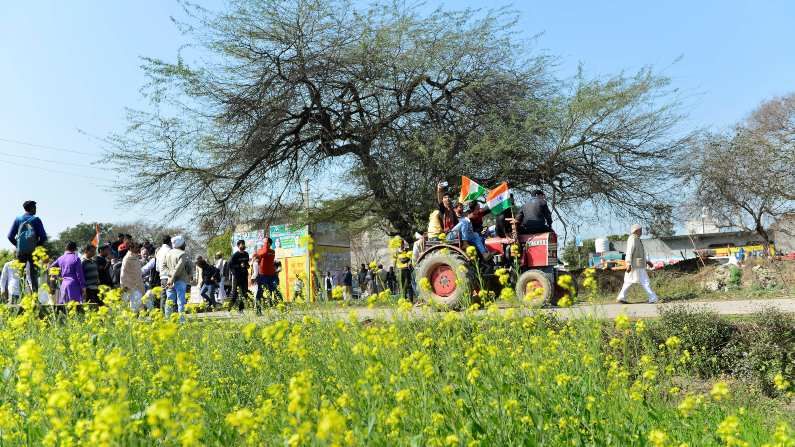Why Punjab farmers object to cess-free agri-transactions?
Farmers protect
- Vivian Fernandes
- Last Updated : July 1, 2021, 11:02 IST

When you buy or sell stocks on a trading platform, you pay no brokerage charges. There is Securities Transaction Tax of 0.1 percent, and stamp fee of 0.015 percent. These are negligible charges.
Compare that with selling wheat and ordinary rice to the government in a regulated mandi in Punjab. The buyer has to pay the minimum support price, which tends to be higher than the market price. On this they have to pay Rural Development Fee of 3 percent, Mandi Cess of 3 percent and commission agent fee of 2.5 percent. It adds up to 8.5 percent.
So farmers should welcome a law that allows agricultural produce to be traded without payment of such high charges? But farmers from Punjab and Haryana have been protesting against the central government law for about 40 days on the borders of Delhi braving cold and Covid-19. Why should they object to something that benefits them?
The reason is that it is the government that almost entirely buys wheat and rice in Punjab and Haryana through the Food Corporation of India (FCI) or state agencies. (Private traders don’t because they can buy wheat and rice at lower rates in other states). They pay the charges; the farmers don’t. These charges in turn add to the country’s food subsidy bill and are a burden on the taxpayers of the country.
The farmers fear that FCI will leverage the new law to buy wheat and rice from outside the mandis to escape the high charges. This will deprive the mandis of revenue and they will wither away in course of time. Large companies like the Adani group, which already provide storage and logistics facilities to FCI will step in. They will charge very low fees for their services, putting the states’ commission agents out of business. The commission agents double up as moneylenders to the farmers; they provide them loans not only for raising crops but also to meet the expenses of weddings and other rites of passage. Companies are unlikely to do this. Another fear is that, the central government will reduce procurement of wheat and rice to levels that are needed for distribution as rations. Currently, there is excess procurement which tends to get wasted or has to be sold in the international market at a loss.
(The mandis can reduce their charges and fees to about 1.5 percent. That will prevent a shift of trades as they have the space and facilities for bulk handling of produce. But doing so would hurt those who gain from evading these charges. There will also be less money available for the upkeep of roads that connect villages to mandis. The state government could finance these from the budget, but with a quarter of Punjab’s tax revenues subsidising free electricity for farms, its finances are strained).
Farmers in Punjab, Haryana and Western Uttar Pradesh will need to shift out of rice and wheat. But there are no alternatives which are as remunerative. Intensive research has resulted in the development of wheat and rice plants which are responsive to fertiliser and water and produce a lot of grain. They have also been made resilient to pests and pathogens.
Maize is another crop which is as high-yielding as rice and wheat and also resilient, but it is used more as feed for dairy animals, fish, pigs and poultry. Indians do not consume meat in the quantities that those in the west and East Asia do for cultural reasons and also because many consumers cannot afford to do so. But maize consumption rises with prosperity as people tend to consume more proteins than cereals.
India is the world’s second largest importer of edible oil. Every year (2020 excluded, because of pandemic-induced disruption), it imports about 15 million tonnes of cooking oil. Oil palm is the most efficient source of edible oil, yielding about four tonnes per hectare. Mustard currently yields about 400 kg per hectare. The Solvent Extractors Association, which is a grouping of cooking oil producers, says higher mustard cultivation can help in cutting the import bill. In 2017, it had launched Mission Mustard to sensitize the government to push mustard in the country. It wanted 25 percent of land in Punjab and Haryana to be diverted to maize in the kharif (rainy) season and to mustard in the rabi or winter season with incentives like assured procurement at support prices.
But support prices in India tend to be above market prices. In 2018, the government decided that support prices would be 50 percent above the paid-out cost of production. This is fine so long as they are below or equal to the import price. If they are higher, the produce become uncompetitive, and internationally unsalable, as has happened with Indian wheat and sugar.
For costs to be low, productivity must rise. This can happen by breeding high yielding varieties or making them resilient to pests and pathogens so that yields are protected from losses. The agricultural exporting nations of the world are relying on biotechnology or genetic engineering technology (GM) to achieve this. But for political reasons India has turned its back on GM and gene-editing technologies.
So whether it is rapeseed-mustard, soybean or maize, India’s average yields are much lower than those of the West. India must take an ecosystem approach. The three central legislations are a piecemeal attempt at reform. They don’t go far enough.
Download Money9 App for the latest updates on Personal Finance.
Related
- ‘ऑपरेशन सिंदूर’ में मारे गए 100 आतंकवादी, राजनाथ सिंह ने किया खुलासा
- Building a portfolio with Debt Mutual Fund
- 30 years of reforms: Looking back at a watershed moment
- Regulatory changes required for making SPACs a successful regime
- Term plan: Beware of these traps
- Insurance Awareness Day: Are you protected from these risks?

